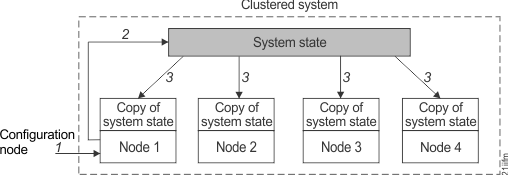The state of the clustered system holds all of the configuration and internal data.
The system state information is held in volatile memory. If the mainline power fails, the node maintains the internal power long enough for the system state information to be stored on the internal disk drive of each node, and the write cache data and configuration information that is held in memory is stored on the internal disk drive of the node. If the partner node is still online, it attempts to flush the cache and continue operation with the write cache disabled.
Figure 1 shows an example of a system that contains multiple nodes. The system state shown in the shaded box does not actually exist. Instead, each node in the system maintains an identical copy of the system state. When a change is made to the configuration or internal system data, the same change is applied to all nodes.
The system contains a single node that is elected as the configuration node. The configuration node can be thought of as the node that controls the updating of system state. For example, a user request is made (1), that results in a change being made to the configuration. The configuration node controls updates to the system (2). The configuration node then forwards the change to all nodes (including Node 1), and they all make the state change at the same point in time (3). Using this state-driven model of clustering ensures that all nodes in the system know the exact system state at any one time. If the configuration node fails, the system can elect a new node to take over its responsibilities.
